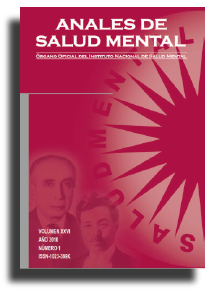Terapia cognitivo-conductual en bulimia nerviosa
Publicado: 14 de agosto de 2010
Palabras clave:
BULIMIA NERVIOSA, COGNITIVO, ANOREXIAResumen
La bulimia nerviosa es uno de los dos trastornos de alimentación más importantes que existen, cuya prevalencia en poblaciones jóvenes, así como la morbimortalidad entre los trastornos psiquiátricos, es considerada signifi cativa. El tratamiento es interdisciplinario e incluye distintas intervenciones terapéuticas, como la psicofarmacológica, la familiar y la cognitivo-conductual. El éxito de la terapia cognitivo-conductual en bulimia nerviosa ha sido ampliamente demostrado y se considera la más estudiada hasta el momento en esta patología. El contribuir a mejorar la comprensión de la terapia cognitivo-conductual en el tratamiento de la bulimia nerviosa y la escasez de publicaciones en nuestro medio nos motivaron a realizar una revisión actualizada de la literatura. Revisamos la teoría original de Fairburn hasta su nueva teoría trasdiagnóstica, mencionamos los perfi les clínicos de la bulimia, proponemos la operacionalización de “conductas alimentarias problema” de las pacientes en dos principales: vómitos autoinducidos y miedo a engordar. Recopilamos las técnicas descritas y utilizadas en bulimia hasta el momento, y concluimos señalando aspectos importantes en la modificación del sistema de autoevaluación disfuncional y propuestas alternativas para la prevención de recaídas.
Palabras clave: Bulimia Nerviosa, Terapia cognitivo-conductual.
Referencias:
-
Halmi KA. Anorexia and Bulimia Nervosa. In Lewis M. Child and adolescent Psychiatry. A comprehensive textbook. Philadelphia. 2002.
-
Lilly R. Extracts from “best treatment” in Bulimia Nervosa. Clinical Review BMJ.2003; 327(16):380-1.
-
Patton CG. Mortality in eating disorders. Psychol Med 1998; (118):947.
-
Hoek HW, Van Hoeken D. Review of the prevalence and incidence of eating disorders. Int J Eat Disord. 2003; 34: 383-96.
-
Yager J, Devlin M, Halmi K, Herzog D, Mitchell J, Powers P et al. Practice guidline for the treatment of patients with eating disorders. Third edition. Http// www. psych.org/psych_pract/pq/reviewform.cfm
-
Instituto Especializado de Salud Mental. Estudio Epidemiológico Metropolitano de Salud Mental 2002. Informe General. Anales de Salud Mental 2002; 18 (1, 2). Lima.
-
Instituto Especializado de Salud Mental. Estudio Epidemiológico de Salud Mental en la Sierra Peruana. Informe General Anales de Salud Mental 2003, 19(1, 2). Lima.
-
Instituto Especializado de Salud Mental. Estudio Epidemiológico de Salud Mental en la Selva Peruana. Informe General. Anales de Salud Mental 2005, 21 (1, 2). Lima.
-
American Psychiatric Association. Practice guidelines for treatment of patients with eating disorders. Am J Psychiatry 2000; suppl (1): 157.
-
Beber C, Benedetti C, Goldwarg. Los profesionales de la salud: su integración en equipos interdisciplinarios. En Becker E, Benedetti C, Goldwarg N (compiladores) Anorexia, Bulimia y otros trastornos de la conducta alimentaria. Prácticas interdisciplinarias. Buenos Aires; 1996. pg. 229-45.
-
Taki, C y col. Bulimia Nervosa. São Paulo. Ed psique. São Paulo. p. 124-31.
-
Segal E, Cordas TA, Melo FLG, Larino MA, Alvarenga M, Bucaretchi H e col. Bulimia Nervosa: Tratamento. Em Bulimia Nervosa. J bras psiq 1995; 44 (sup 1): 25-33.
-
Mitchell JE, Peterson CB, Myers T, Wonderlich S. Combining Pharmacotherapy in the treatment of patients with eating disorders. In Andersen A. (editor). The Psychiatric Clinics of North America. Eat Disord. 2001; 21(4): 315-25.
-
Vitello B, Lenderhendler I. Research on eating disorders: Current status and future prospects. Biol Psychiatry. 2000:47: 777-86.
-
Figueroa G. La Terapia Cognitivo Conductual en los Trastornos de la alimentación. En Behar R, Figueroa G. Anorexia y Bulimia: Clínica y terapéutica. Santiago. Ed Mediterráneo; 2004. p.177-200.
-
Craighead LW, Agras WS. Mechanisms of action in cognitive-behavioural and pharmacological interventions for obesity and Bulimia nervosa. J of Consult Clin Psychol. 1991; (59): 115-25.
-
Agras WS, Rossiter ES, Arnow B, Telch CF, Raeburn SB, Bruce B et al. Pharmacologic and cognitive behavioral treatment for Bulimia nervosa: A controlled comparison. Am. J of Psychiatry. 1992; (149): 82-7.
-
Leitenberg H, Rosen CJ, Wolf J, Vara JC, Detzer MJ, Scrbrik D, et al. Comparison of cognitive behaviour and desipramine in the treatment of Bulimia nervosa. Behav Res and ther. 1994; (32): 37-46.
-
Agras, W S. Short_ term psychological treatments for binge eating. In Fairburn CG, Wilson GT. Binge Eating: Nature, assessment and treatment. New York. Guilford Press; 1993.
-
Garner DM, Rockert W, Davis R. et al. Comparison between cognitive-behavioral and supportive- expressive therapy for Bulimia nervosa. Am J Psychiatry. 1993; (150):37-46.
-
Beck A, Rush J, Shaw B. y col. Terapia cognitivoconductual de la depresión. Madrid. Ed Desclee de Brouner.; 1983.
-
Fairburn CG. A cognitive behavioural approach to the management of Bulimia nervosa. Psychol Med. 1981; (11): 707-11.
-
Wilson T, Fairburn CG, Agras WS. Cognitivebehavioral therapy for Bulimia nervosa. In Garner D. The handbook of treatment of eating disorders. The Guilford Press. New York; 1997. p. 278-94.
-
Byrne SM, Mc Lean NJ. The cognitive-behavioral model of bulimia nervosa: a direct evaluation. Int J Eat disord. 2002; 31(1): 17-51.
-
Fairburn CG, Cooper Z, Shafran R. Cognitive behaviour therapy for eating disorders: a transdiagnostic theory and treatment. Behav Res and ther. 2003; 41(5): 509-28.
-
Shafran R, Cooper Z, Fairburn CG. Clinical perfectionism: a cognitive-behavioral analysis. Behav Res and ther. 2002; 40 (7): 773-91.
-
Bulik C, Tozzi F, Anderson Ch, Mazzeo S, Aggen S, Sulllivan P. The relation between eating disorders and components of perfectionism Am J Psychiatry. 2003; 160: 366-8.
-
Srinivisagam N, Kaye W, Plotnicov K, Greeno C Weltzin T, Rao R. Persistent perfectionism, symmetry, and exactness alter long term recovery from anorexia nervosa. Am J Psychiatry. 1995; 152(11): 1630-4.
-
Herlein A. El rol de la psicoterapia interpersonal en el tratamiento de las disorexias y la depresión. En Behar R, Figueroa G. Anorexia y Bulimia: Clínica y terapéutica. Santiago. Ed Mediterráneo. 2004. p.177-200.
-
Porres Dieguez P. La Terapia Interpersonal de la Bulimia Nerviosa. Psiquiatría Pública. 1999;11(2): 118-21.
-
Fairburn CG, Jones R, Peveler RC, Hope RA, O Conor M. Psychotherapy and Bulimia nervosa Long-term effects of interpersonal psychotherapy, behavior therapy, and cognitive behavior therapy. Arch Gen Psychiatry.1993; 50 (6): 419-28.
-
Wilson BT. Treatment of Bulimia Nervosa. When the CBT fails. Behav Res Ther. 1996; 34 (3): 197212.
-
Herzog DB, Nussbaum KH, Marmor AK. Comorbidity and outcome in eating disorders. In Yager J (editor). The Psychiatric Clinics of North America.1996; 19(4): 843-61.
-
Melin P. Comorbidade dos trastornos alimentares. Em Antunes MA, Appolinário JC, Galvão AL, Countinho W. Trastornos alimentares e obesidade. Porto Alegre. Artmed.; 1998. p. 97-110.
-
Eldestein CK, Yager J. Eating Disorders and affective Disorders. In Yager J, Gwirtsman H, Edelstein C. Special problems in managing eating disorders. Am Psychiatric Press. London; 1992. p. 15-51.
-
Rubenstein CE, Piggott TA, l’ heureuxf, et al. A preliminary investigation of the lifetime prevalence of anorexia and bulimia nervosa in patients with obsessive compulsive disorders. J of clinical psychiatry, 1992; (53) 9: 14-5.
-
Mitchell J, Specker SH, Edmonson K. Management of substance abuse and dependence. In Garner D. The handbook of treatment for eating disorders. New York. p 461-9.
-
Mitchell JE, Pyle RL, Specker S, Hanson K. Eating disorders and chemical dependency. In Yager J, Gwirtsman H, Edelstein C. The special problems in managing eating disorders. Am Psychiatry Press. London; 1992. p. 1-15.
-
Pendleton L, Tisdale H, Marler M. Personality Pathology in Bulimics versus controls. Compr Psychiatry. 1991; 32 (6): 5176-20.
-
Pope H G, Hudson JI. Are eating disorders associated with borderline personality disorder? A critical review. Int J Eat Disord. 1989; 8(11): 1-8.
-
Wonderlich S, James ME. The role of personality in the onset of eating disorders and treatment implications. In Andersen A. The Psychiatric Clinics of North America. Eating Disorders. 2001; 24 (2): 249-270.
-
Lacey JH, Evans CDH. The multivist: a multiimpulsive personality disorders. Br J of addiction. 1996; (81):641-9.
-
Safer D, Telch C, Agras S. Dialectical Behavior Therapy for Bulimia nervosa. Am J Psychiatry. 2001; (158): 632-4.
-
Buceta JM. Programas de modifi cación de conductapara el tratamiento de la anorexia nerviosa. EnBuceta JM, Bueno AM. Tratamiento Psicológicode hábitos y enfermedades. Editorial Pirámide.Madrid; 1996. p. 309-41.
-
Thomas J. Special series: samples from four frontiersof eating disorders Research. Overview of the specialseries Behavior Therapy. 2000; (31): 187-93.
-
Duschesne M. Abordagem cognitivocomportamental. Em Antunes MA, Appolinário JC,Galvão AL, Countinho W. Trastornos alimentares eobesidade. Artmed. Porto Alegre; 1998. p. 97-110.
-
Halmi KA, Agras WS, Mitchell J, Wilson T, Crow S, Bryson SW, et al. Relapse predictors of patients withbulimia nervosa who achived abstinence through cognitive behavioral therapy. Arch Gen psychiatry.2002; 59(12):1105-9.
-
Wilson GT, Fairburn CG, Agras WS, Walsh BT,Kraemer H. Cognitive-behavioral therapy forbulimia nervosa: time course and mechanisms of change. J Consult Clin Psychol. 2002; 70(2):267-74.
-
Constantino MS, Arnow BA, Agras WS. Theassociation between patients characteristics andthe therapeutics alliance in cognitive-behavioraland interpersonal therapy for Bulimia Nervosa. J of consult clin Psicol. 2005; 73(2): 203-11.
-
Fairburn CG, Agras S, Walsh T, Wilson T, Stice E. Prediction of outcome in Bulimia nervosa by early change in treatment. Am J Psychiatry 2004; 161(12): 2322-4.
-
Garner D. Psychoeducational Principles in treatment.In Garner D. The handbook of treatment for eating disorders. the Guilford Press. New York; 1997. p. 243-57.
-
Crispo R, Figueroa E, Guelar D. Grupospsicoeducativos para los trastornos del comer. En: Anorexia y Bulimia lo que hay que saber. Un mapa para recorrer un territorio trastornado. Barcelona: Editorial Gedisa; 2005. p. 158-163.
-
Cordas TA, Das Neves JEP. Escalas de avaliação de trastornos alimentares. Rev psiq clin. 1999; 26(1): 41-47.
-
Fairburn CG. La superación de los atracones decomida. Ed Paidos América. S.A. Barcelona; 1998.
-
Terence W, Fairburn CG. Cognitive treatments for eating disorders. J Consult and Clin Psychology.1993;81(2):261-9.p. 225.
-
Garner DM, Olmstead MP, Bohr Y, Garfi nkel PE. The Eating Attitudes Test. Psychometric features and clinical correlates. Psychol Med. 1982; 12:871-8.
-
Raich R. Anorexia y Bulimia. TrastornosAlimentarios. Madrid. Ediciones Pirámide; 1999.
-
Borda M, Del Rio C, Torres I. Creencias Irracionales en mujeres con anorexia y bulimia nerviosa. C Med Psicosomatic. 2003; (65):16-28.
-
Gempeler J. Historia fotográfica del cuerpo, exposición y prevención de respuesta e integración sensorial como herramientas terapéuticas integradas para la fl exibilización de la distorsión corporal en el tratamiento de la conducta alimentaria. Rev Colomb psiquiatría. 2004; 1(23):9-20.
-
Rodríguez M, Gempeler J. La corporalidad en los trastornos de la alimentación. Body Image Eat Disord. 1999; 23(4):293-310.
-
Boskind-White M, White W. Bulimia/Anorexia. The binge/purge cycle and self starvation. Third Ed. New York. Ediciones Norton; 1997.
-
Roca E, Roca B. La Bulimia Nerviosa y su Tratamiento: La Terapia Cognitivo Conductual de Fairburn. http://www. cop.es/colegiados/ PV00520/articulo2.pdf.
-
Tonks A. Information for patients what happens during cognitive behaviour therapy for bulimia. BMJ. 2003: 327-8.
-
Mitchell JE, Agras WS, Wilson GT, Halmi K, Kraemer H, Crow S. A. trial of a relapse prevention strategy in women with bulimia nervosa who respond to cognitive-behavior therapy. Int J Eat Disord. 2004; 35(4): 549-55.

Descargas
Publicado
Número
Sección
Licencia
Derechos de autor 2023 Anales de Salud Mental

Esta obra está bajo una licencia internacional Creative Commons Atribución-NoComercial-CompartirIgual 4.0.
Publicación del Instituto Nacional de Salud Mental “Honorio Delgado - Hideyo Noguchi”





